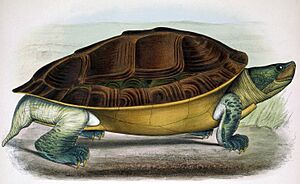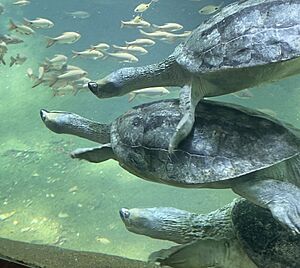Burmese roofed turtle facts for kids
Quick facts for kids Burmese roofed turtle |
|
|---|---|
 |
|
| Female | |
| Conservation status | |
| Scientific classification | |
| Genus: |
Batagur
|
| Species: |
trivittata
|
| Synonyms | |
|
|
The Burmese roofed turtle (Batagur trivittata) is a special kind of turtle. It is one of six turtle species in the Batagur group. These turtles live only in the rivers of Myanmar.
Long ago, there were many Burmese roofed turtles. But their numbers dropped very quickly. People even thought they were extinct. Then, in 2001, two small groups were found again. These groups were in the Chindwin and Dokhtawady rivers. By 2018, fewer than 10 adult turtles were known to exist in the wild. This makes the Burmese roofed turtle one of the most critically endangered turtles in the world.
Contents
What Do They Look Like?
Adult male and female Burmese roofed turtles look different. Males are smaller and have an olive-green shell, called a carapace. They have a black stripe on their head and neck. Three more black stripes go down their shell. Males also have a longer tail and an ivory-white belly, called a plastron.
During the time they mate, the male's green head turns bright yellow. It also gets bold black marks. Female Burmese roofed turtles grow much larger than males. Their bodies are mostly dark brown to grayish-black. This color is on their head, shell, and belly.
What Do They Eat?
The Burmese roofed turtle is a herbivore. This means it eats only plants. They mostly eat plants that grow in or near the water where they live.
In zoos, these turtles eat different foods. They are given water spinach and special fish food pellets. Sometimes, they also eat figs when they are in season. Other healthy plant foods are given if needed.
Baby Turtles!
Female Burmese roofed turtles in zoos can start laying eggs around 14 years old. In the wild, they might start laying eggs when they are 20 years old or older.
Each time a female lays eggs, it's called a clutch. They usually lay between 20 and 25 eggs in one clutch. These turtles like to build their nests on sandy riverbanks. They choose spots with little to no plants or shade. After laying eggs, they stay in deep pools of water. These pools are called "Aike" by local people.
Why Are They in Danger?
The Burmese roofed turtle faces many dangers. This is because they live only in one area. One big problem is that their homes are being ruined. Other threats include animals eating their eggs or young. People also collect too many eggs.
Sadly, adult and young turtles are sometimes caught illegally. This is for food or to be sold. Pollution in the rivers also harms them. Fishing can accidentally catch them. Even climate change, like floods and bad weather, is a threat.
Helping the Turtles
The Burmese roofed turtle is a protected animal in its home country. It is also listed in CITES Appendix II. This means there are rules about trading them. In 2018, about 1,000 Burmese roofed turtles lived in five zoos.
Many of these turtles are kept at the Yadanabon Zoological Gardens in Mandalay. There is also a turtle conservation center in Lawkananda Park, Bagan. Some turtles have been released back into the wild. Researchers have found more turtles and brought them to safety in zoos.
In 2014 and 2018, health checks were done on the turtles in zoos. This was to make sure they were healthy. It also stopped any diseases from spreading to wild turtles if they were released. The checks showed the turtles were very healthy.
Releasing Them Back
Releasing these turtles back into the wild can be tricky. This is because they like to travel far downstream. Some turtles were released without special help. But it was hard to keep track of them.
Now, a new method called "soft release" is used. This helps the turtles get used to the sandy areas where they are released. This way, they don't travel too far. This makes it easier for scientists to watch them.
Two groups of 30 turtles were released into the Chindwin River. These turtles were chosen to have different genes. This helps make the wild population stronger.



